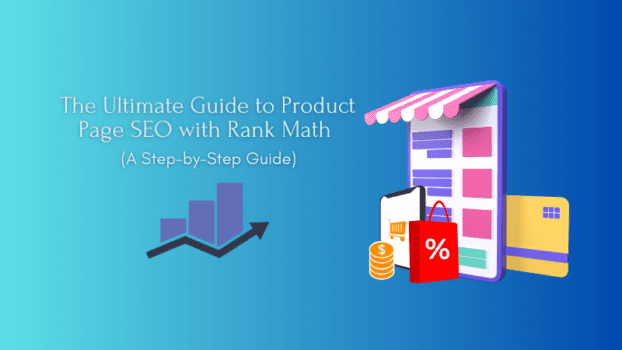Looking to flood your online store with buyers this holiday season?
Did you know that the BEST source of targeted traffic for your online store is organic search traffic?
Well, if you’re like most online store owners, then you may have always believed that in order to generate buyers, you need to spend thousands of dollars on ads, have millions of followers on social media, and become a famous influencer.
The truth, however, is that while those things are obviously important, research has shown over time that organic search traffic trumps them all! Yes, none of these things compare to traffic from the search engines.
Just think about this: in 2019, BrightEdge reported that 53.3% of all website traffic is generated from organic search and that SEO drives 1,000%+ more traffic than organic social media!
And this: 60% of marketers reported that inbound (SEO, blog content, etc.) is their highest quality source of leads [HubSpot].
What can you make of these statistics?
Without any doubt…
- Search engine traffic is the best form of online traffic.
- If you want to drive targeted traffic to your online store, you should focus on optimizing your e-commerce product pages to rank highly on the SERPs.
This is very important because, according to a study by Ahrefs the average top-ranking page also ranks in the top 10 search results for nearly 1,000 other relevant keywords.
So, how do you SEO optimize your product pages to get a piece of this organic search traffic?
Well, that is what this post is all about.
You see, in the last few weeks, I've been busy working on a number of e-commerce sites that I run, optimizing them for the Q4 shopping frenzy. Over this period, I learned a few things about e-commerce product page SEO, which I want to gladly share with you in this article.
In this guide, you’ll learn how to optimize your e-commerce websites for SEO using Rank Math, one of the best tools for eCommerce SEO on the market right now. It doesn’t matter whether you're an online store owner, a seasoned marketer, or an SEO professional; this guide will equip you with simple, savvy e-commerce SEO tips to catapult your product pages to the top of SERPs.
So, without any further ado, let’s jump in!
Table of Contents
Recommended: How to Optimize Content for SEO Using Rank Math (In 7 Easy Steps)
What is Product Page SEO?
Product page SEO is the strategic process of optimizing your individual e-commerce product pages for search engines. It's about enhancing the visibility of your products when potential customers search for them on platforms like Google, Bing, or Yahoo. Think of it as the digital storefront sign that draws visitors to your online shop.
Product page SEO is more than just keyword placement. It involves a multifaceted approach, including keyword research, optimizing product descriptions, enhancing images, creating structured data, and more. It's about fine-tuning your pages to cater to both search engines and the human audience.
Why is SEO for E-commerce Websites Important?
So, why does optimizing your product pages for SEO matter?
As the digital landscape continues to evolve, the importance of e-commerce SEO for online store owners, marketers, and SEO professionals cannot be overstated. The world of online commerce is constantly changing, and staying ahead of the curve is essential for success.
The key to getting your products discovered by potential customers is SEO optimization. It's not just about having an online store; it's about making sure your store stands out in the digital marketplace
Here are the top reasons why ecommerce product pages SEO is important:
- Increased Visibility: SEO ensures that your products show up when potential customers search for relevant keywords. Higher visibility means more clicks and potential sales.
- Traffic and Conversions: As we have said earlier, 53.3% of all online traffic comes from organic search. When your product pages rank higher, they receive more organic traffic, which can translate into higher conversion rates and increased sales.
- Boosting product page performance: SEO helps ensure that product pages are optimized for search engines and that keywords are in the right places, making it easier for Google to understand what the page is about.
- Pre-Qualifying Leads: SEO not only brings in more visitors but also helps pre-qualify your leads, ensuring that those who land on your site are interested in your products or services.
- Cost-Effective Marketing: Compared to traditional advertising, SEO is a cost-effective way to promote your products. It offers long-term benefits, and you don't need to pay for each click or impression.
- Brand Awareness: SEO can improve your brand's visibility and awareness, making it cost-effective for eCommerce sites to establish a strong online presence.
- Improved Credibility: Pages that rank well are often perceived as more credible and trustworthy. This trust factor can significantly impact a buyer's decision.
- Better User Experience: SEO practices often involve improving page load times, mobile friendliness, and the overall user experience. This can lead to higher customer satisfaction and loyalty.
- Competitive Advantage: Your competitors are optimizing their product pages. To remain competitive in the digital marketplace, you must not only keep up but strive to outperform others in your niche.
Why Use Rank Math for E-Commerce SEO?
When it comes to e-commerce SEO, the choice of your SEO plugin can make a significant difference. Rank Math is a powerful SEO plugin for WordPress that offers built-in support for WooCommerce SEO.
Here are some reasons why Rank Math is a great choice for e-commerce SEO:
- Automatic Schema-ready content: Rank Math automatically converts your WooCommerce product's information into Schema-ready content. It even pulls the aggregate rating and review fields from the product reviews.
- Affordable: Rank Math's free version offers enough features to optimize your online store, making it an affordable option for businesses of all sizes.
- Dedicated Content Analysis Tests for WooCommerce Products: Rank Math PRO offers dedicated SEO tests for WooCommerce products. This helps you optimize your product pages for SEO.
- Easy to use: Rank Math has an intuitive layout and very defined options, making it easy to use. You will never be in a dilemma.
- Better than the competition: While the rest of the SEO plugins offer very limited e-commerce features in their free versions, Rank Math offers enough to handle everything related to on-page SEO, whether it is adding meta information, creating sitemaps, adding redirections, or adding Schema.
- Advanced functionality: Rank Math gives you full control over all aspects of your on-page SEO. You get options to index or noindex everything manually or using auto-pilot.
- Auto Configuration: Rank Math is smart enough to detect what type of SEO settings are best for your website after you tell it what kind of site you have. It considers industry research while automatically configuring many of the options.
- Google Keyword Rank Tracking: Rank Math allows you to add your keyword and watch how it is ranking in SERPs.
- Full Schema Codex: Rank Math makes it easier for Google to understand your content, and Schema does just that.
- Detailed Documentation: Rank Math has extensive Knowledge Base articles, which will help you never feel stuck while using Rank Math.
From the above, Rank Math is a great choice for e-commerce SEO. It offers features that cater to the specific needs of product pages and has proven to be more efficient than many alternatives.
Recommended: AI SEO Optimization: How to Win the SEO and Content Marketing Game in the Age of AI
Step-by-step Guide to Product Page SEO Using Rank Math
Step 1: Setup Rank Math
Setting up Rank Math on your e-commerce site is pretty easy. Here’s how to set up Rank Math on your e-commerce platform:
Step 1.1: Install the Rank Math plugin
The first step is to install the Rank Math plugin on your e-commerce platform. You can do this by going to the WordPress Dashboard → Plugins → Add New and searching for “Rank Math.” Once you find the plugin, click “Install Now” and then “Activate.”
You may also download the plugin from the Rank Math official website and then upload it to your website by going to the WordPress Dashboard → Plugins → Add New and then Upload
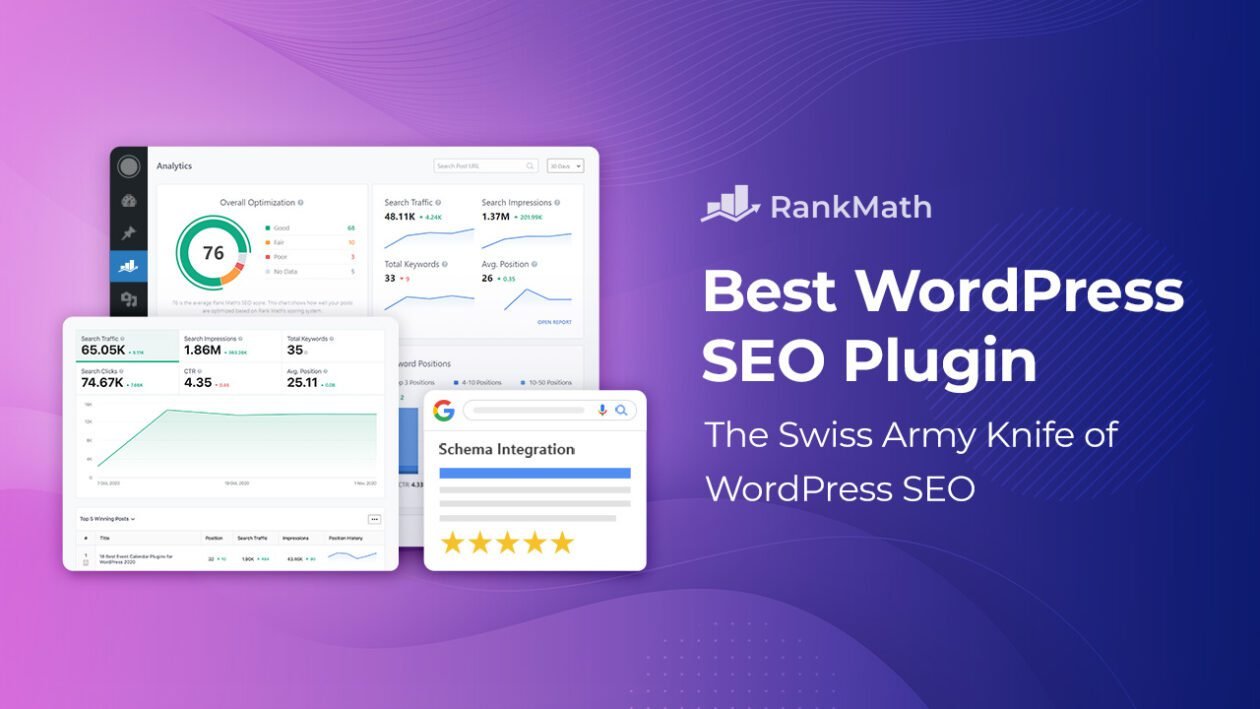
Step 1.2: Run the setup wizard
Once Rank Math is activated, you will be taken to the Rank Math setup wizard. This wizard will help you configure the basic settings for Rank Math on your website. You can also choose to skip the setup wizard and configure the settings manually later.
If you did not use the setup wizard when you first installed Rank Math, you can run it again by heading to WordPress Dashboard → Rank Math SEO → Dashboard → Setup Wizard tab. The setup wizard will guide you through the process of configuring Rank Math for your e-commerce platform.
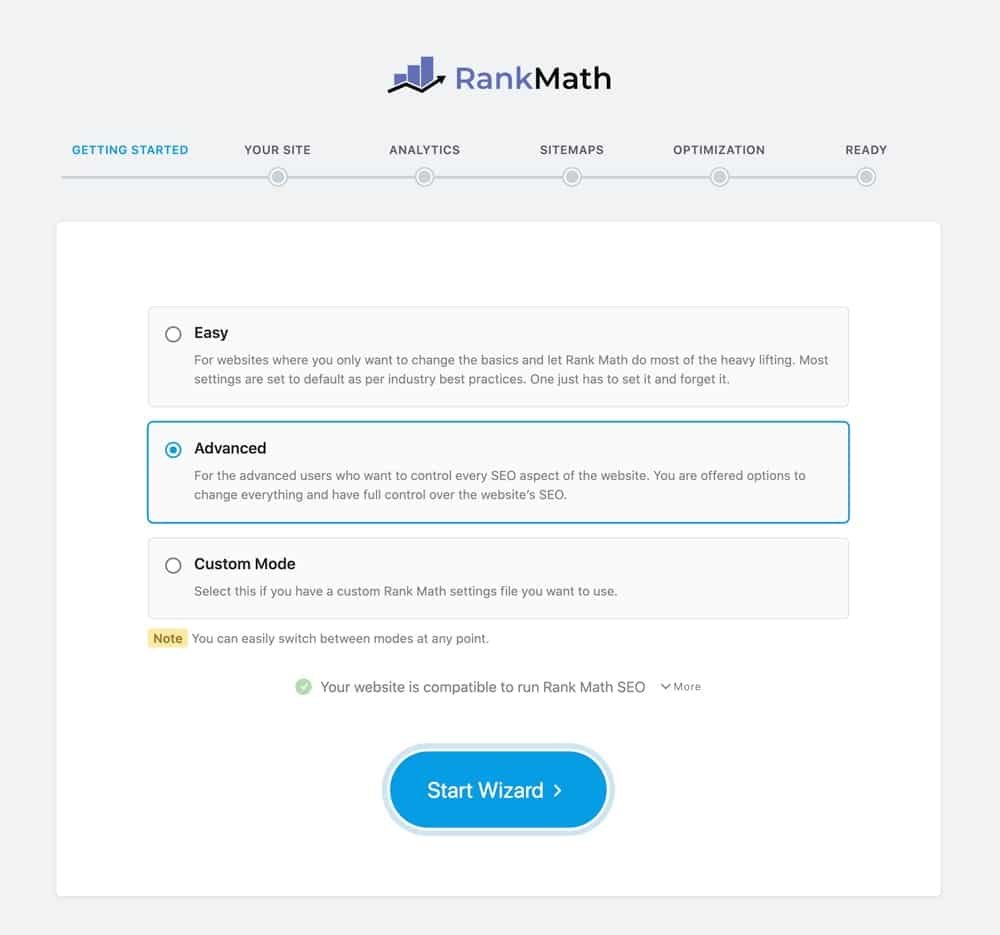
Step 1.3: Configure the settings
Once you have completed the setup wizard, you can configure the settings for Rank Math to optimize your e-commerce platform for SEO. These settings can be enabled by navigating to Rank Math → Dashboard → General Settings → WooCommerce. This module is designed to enhance SEO for WooCommerce stores.
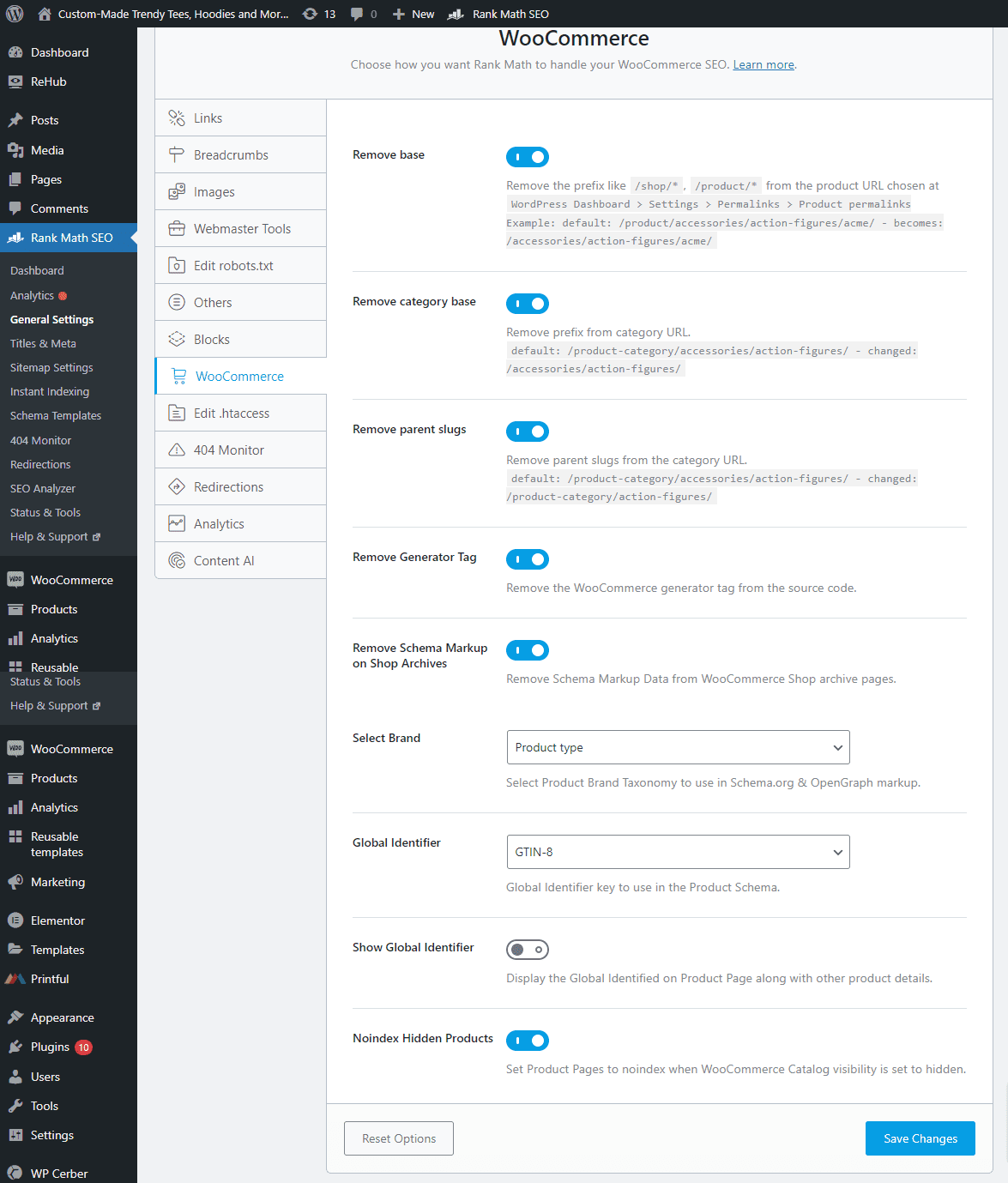
While there are many different settings that you can configure, the most important ones for e-commerce are:
- General: This section contains general SEO settings, such as the title and meta description of your website.
- Titles and Metas: This section allows you to customize the titles and meta descriptions of your individual posts and pages.
- Redirections: Set up redirects for any old URLs that have been changed.
- Sitemap: Generate a sitemap of your website and submit it to Google Search Console.
- Rich Snippets: Enable rich snippets so that your search results listings are more informative.
- Product Schema: Enable product schema so that your products are displayed correctly in Google Search. Schema markup is a type of structured data that helps search engines understand your website better.
- Social: This section allows you to integrate Rank Math with your social media accounts.
Once you have configured the settings for Rank Math, you can start using it to optimize your e-commerce website for search engines. Rank Math offers a variety of features to help you improve your website's SEO, including:
- Keyword research: Rank Math can help you identify the right keywords to target for your website.
- On-page SEO: Rank Math can help you optimize your website's content and code for search engines.
- Technical SEO: Rank Math can help you fix any technical SEO issues on your website.
- SEO insights: Rank Math provides you with insights into your website's SEO performance.
Step 2: Keyword Research
Keyword research is the cornerstone of successful e-commerce SEO. To drive more organic traffic to your product pages, it's essential to choose the right keywords. In this section, we'll explore the importance of selecting the right keywords and how to utilize Rank Math's keyword research tools effectively.
The Importance of Choosing the Right Keywords
Selecting the appropriate keywords for your e-commerce products is crucial for several reasons:
- Relevance: The right keywords ensure that your products are seen by the right audience, increasing the chances of conversion.
- Competition: Opting for keywords with low competition but high search volume can give you a competitive edge in search engine rankings.
- User Intent: Understanding user intent behind specific keywords allows you to tailor your product listings to meet customers' needs effectively.
- Cost-Efficiency: By targeting the right keywords, you can optimize your paid advertising campaigns and reduce costs.
How to Use Rank Math for Keyword Research
First, it’s important to note that Rank Math is not a dedicated keyword research tool. So, it is not a substitute for dedicated keyword research tools like Google's Keyword Planner. But that being said, Rank Math offers several features that can help with keyword research. These include:
- Automatic keyword suggestions: As you start typing a keyword in the Focus Keyword field in the Rank Math SEO settings, Rank Math can pull in automatic keyword suggestions from Google. This can be a helpful way to brainstorm new keyword ideas.
- Google Trends: Rank Math's integration with the Google Trends tool (Rank Math PRO only) helps you check the search trends for keywords and even compare them. With the help of the built-in graph comparison tool, you can compare the various keyword opportunities visually and research which keyword you should be targeting.
- Content AI: Rank Math's Content AI feature can generate keyword suggestions based on your focus keyword. This can be a helpful way to find long-tail keywords and related keywords.
Here's how to use Rank Math features for keyword research:
Step 2.1: Use Rank Math's Automatic Keyword Suggestion
Start by opening or creating a new product in your website's editor. With the content editor opened, scroll down the page and look for Rank Math's Metabox.
In the Rank Math Metabox, you'll find a “Focus Keyword” field. In the free version of Rank Math, you can select up to five keywords for a single post. However, you need to connect your website to your rankmath.com account to enjoy this privilege. But, if you're a Rank Math PRO user, you can use an unlimited number of focus keywords.
When you start typing in the Focus Keyword field, Rank Math will provide keyword suggestions automatically. You can click on any of these suggestions to add them to the Focus Keyword field. This feature is available in both the free and PRO versions.
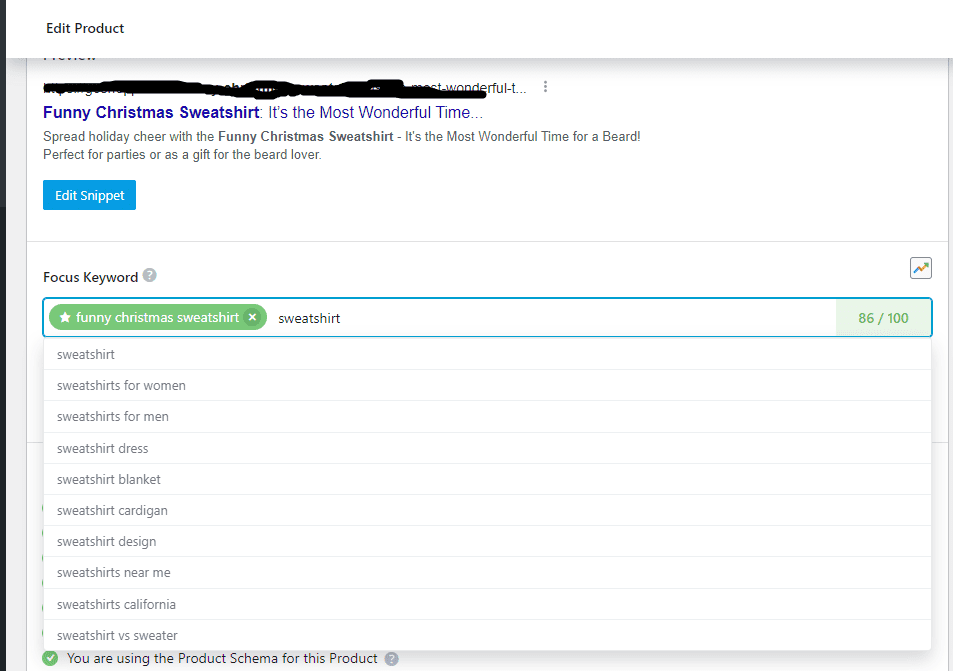
Step 2.2: Use Google Trends Integration (PRO Users)
If you're a Rank Math PRO user, you can also take advantage of the integration with Google Trends. In the Metabox, click on the graph icon to view keyword search trends and compare them. This feature helps you make informed keyword choices.
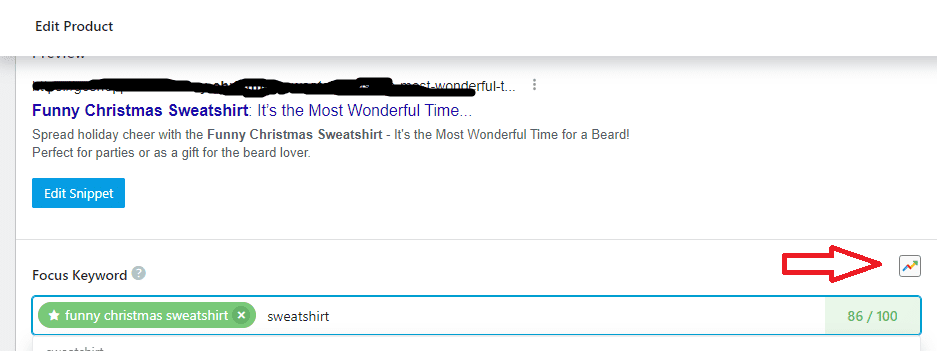
Step 2.3: Use Content AI
To use Rank Math's Content AI for keyword research, open the product page where you want to improve your content and then enter your focus keyword. This is the keyword you want to perform keyword research for. After entering the focus keyword, click the “Content AI” button to generate keyword suggestions.
Rank Math's Content AI will connect to an AI server to provide suggestions and insights based on the keyword and target location you've specified. Review the keyword suggestions and select the ones that are relevant to your content and have a good search volume.
Rank Math's Content AI tool provides actionable suggestions for optimizing your content based on the keyword and target country you select. It assists in improving the quality and relevance of your content for SEO purposes.
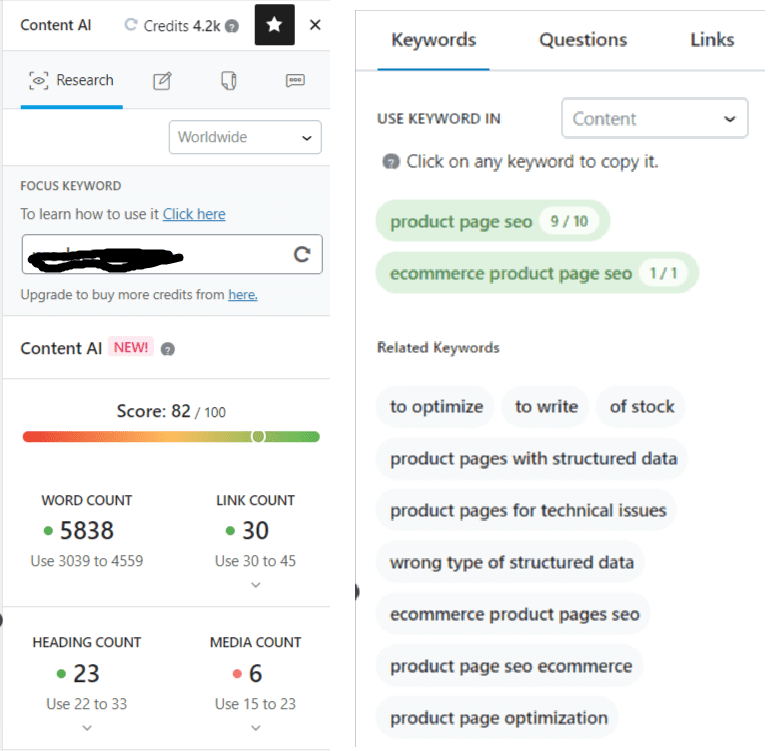
IMPORTANT: As already noted above, Rank Math is not a dedicated keyword research tool, however, by using these Rank Math features for keyword research and optimizing your content for your target keywords, you can improve your website's SEO and ranking in search engine results pages (SERPs). This can lead to more traffic and sales for your business.
Recommended: Rank Math’s Content AI 2.0: A Game-Changer for AI Copywriting? (My Honest Review)
Step 3: On-page Optimization
Once you've identified the keywords and LSI/NLP terms that can help your product pages rank highly on search engine result pages (SERPs), your next move is to ensure that your e-commerce product content is not just relevant but also irresistible. This is where on-page optimization comes into play.
On-page optimization is the bridge between potential customers discovering your product pages and choosing to stay and explore. It's not just about SEO; it's about ensuring your content resonates with users and guides them seamlessly toward their purchasing decisions.
Using Rank Math for On-page Optimization
When it comes to on-page optimization, the Rank Math SEO plugin is one of the best in the market right now. Rank Math offers a lot of easy-to-use features for optimizing your product pages for SEO.
To optimize your product pages for SEO using Rank Math follow these steps:
Step 3.1: Optimize the Category URLs
Rank Math allows you to select the permalink structure for your WooCommerce products. You can find the settings by navigating to Rank Math SEO → General Settings → WooCommerce. From here, you can optimize the category URLs by removing the parent category slugs. Simply enable the Remove parent slugs option.

Step 3.2:Optimize the Category Images
Images are important and necessary for any E-commerce website. If you are selling physical products, images are the primary medium for potential customers to get to know your products. Use only high-quality, optimized images – poor-quality images may cost you, customers.
Key strategies for optimizing images for SEO include:
- File Naming: Name your images descriptively and include relevant keywords. This helps search engines understand the content of the image and its context.
- Alt Text: Always provide an informative alt text for each image. Alt text is essential for accessibility and SEO. It should describe the image and include relevant keywords.
- Image Dimensions: Resize your images to match the display dimensions required on your website. This reduces the load time and improves the user experience, which can positively impact SEO.
- Image Sitemaps: Include images in your XML sitemap to help search engines index them more effectively.
To optimize your product images for SEO using Rank Math, navigate to Rank Math SEO → General Settings → Images.
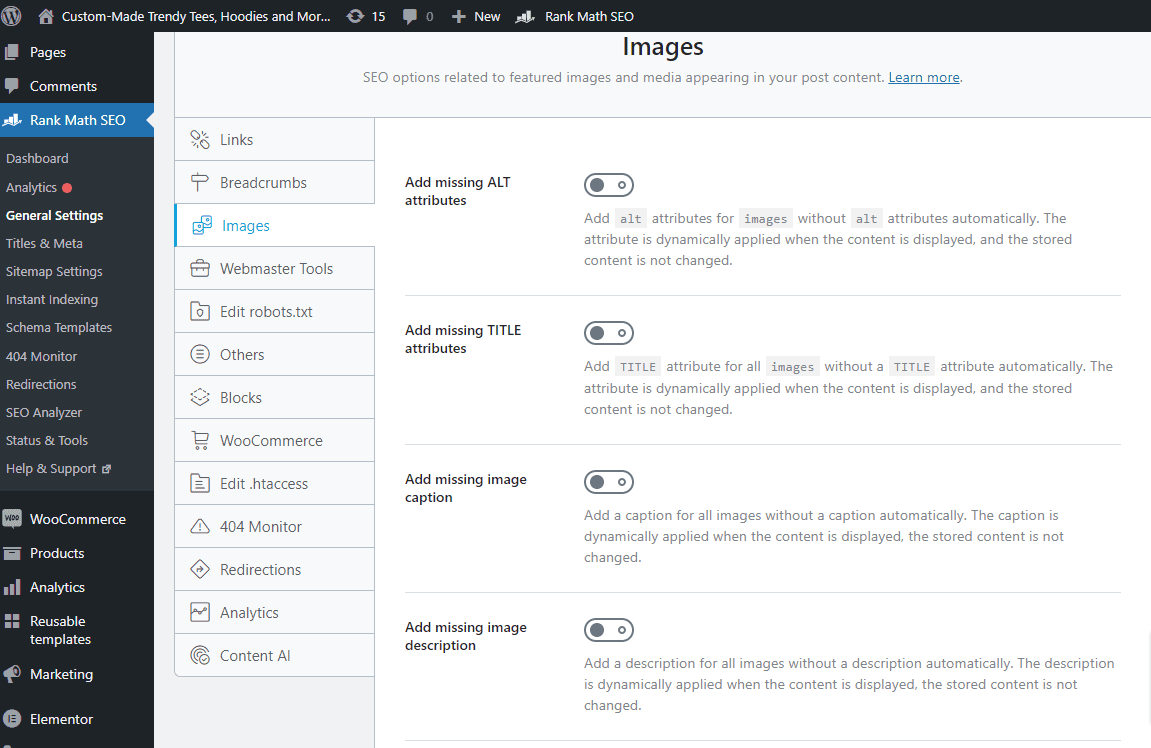
Step 3.3: Use Rank Math's Content Analysis Tests
Rank Math's content analysis tests help you identify and fix common on-page SEO issues with your product pages. To use these tests, simply edit or create a new product. While you are in the content editor, scroll down to the ‘Rank Math’ meta box and enter your focus keyword. This is the keyword or phrase you have chosen to optimize your product for.
With your focus keyword selected, follow Rank Math's SEO Score and hints to better optimize your content. To increase your chances of appearing in the top results on search engine result pages for your focus keyword:
- Use the focus keyword in your SEO title. Your product titles are one of the most important factors in your e-commerce SEO strategy. They are the first thing that potential customers will see when they search for your products on Google or other search engines. For this reason, it is important to craft SEO-friendly product titles that are clear, concise, and informative. Use your focus keyword in your product title, but avoid keyword stuffing. This will help search engines understand what your page is about and improve your chances of ranking for that keyword.
- Use the focus keyword in the image alt attributes. Images are an important part of any e-commerce website. They can help showcase your products in a visually appealing way and encourage potential customers to buy. To help search engines understand what your images are about, use your focus keyword in the alt attributes of your product images. For example, instead of naming an image “IMG_1234.jpg,” you can name it “red-running-shoes.jpg,” and for the alt text, you can use “A pair of red running shoes.” This will improve your chances of ranking for that keyword.
- Use the focus keyword in the product description: Your product descriptions are one of the most important factors in your e-commerce SEO strategy. They are the text that appears on your product pages, and they are used by Google and other search engines to understand what your products are and how they should be ranked in SERPs. By using your focus keyword in the product description of your product page, the search engines will be able to better understand what your product is about and improve your chances of ranking for that keyword.
- Use the focus keyword in the product URL: Use your focus keyword in the URL of your product page. This will help search engines understand what your page is about and improve your chances of ranking for that keyword.
- Use the focus keyword in the meta description: Use your focus keyword in the meta description of your product page. This will help search engines understand what your page is about and improve your chances of ranking for that keyword. Make sure it accurately represents the content on the product page and it matches the user's intent. Encourage users to take action by using phrases like “Shop now,” “Learn more,” or “Discover” and keep it within 150-160 characters to ensure it displays in full on search engine results.
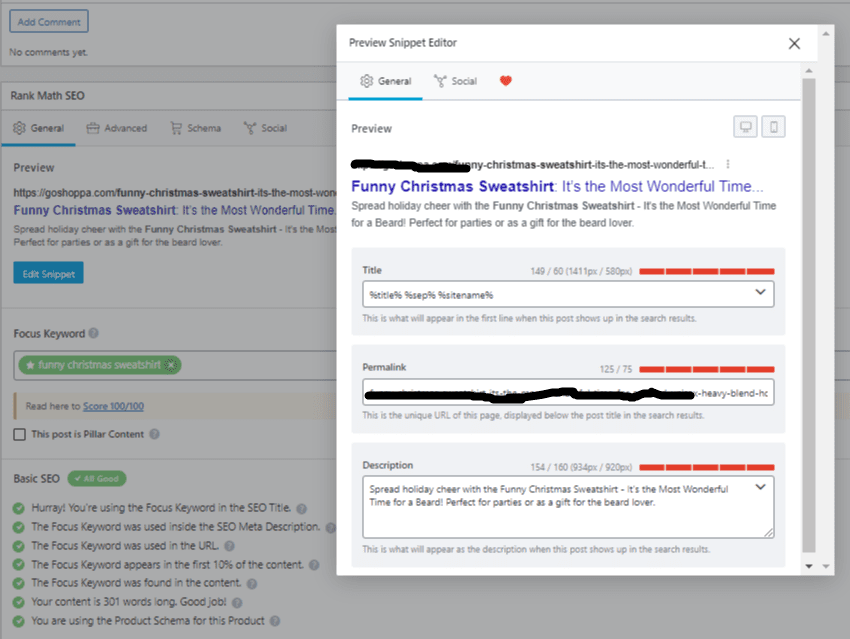
Note: While the Rank Math SEO free version includes the default content analysis tests, Rank Math PRO offers dedicated SEO tests for WooCommerce products.
Related: SEO Copywriting Checklist: 6 Proven Strategies for Crafting Content that Ranks and Drives Traffic
Step 3.4: Use Rank Math's Analytics Module
Rank Math's analytics module allows you to track your website's traffic and see how your product pages are performing. This can help you identify areas for improvement so you can optimize your product pages for SEO effectively.
To take advantage of this tool, you will need to first configure the Search Console and Analytics property going to Rank Math SEO → General Settings → Analytics. Once the essential settings have been configured, you can access the Analytics dashboard under Rank Math SEO → Analytics.
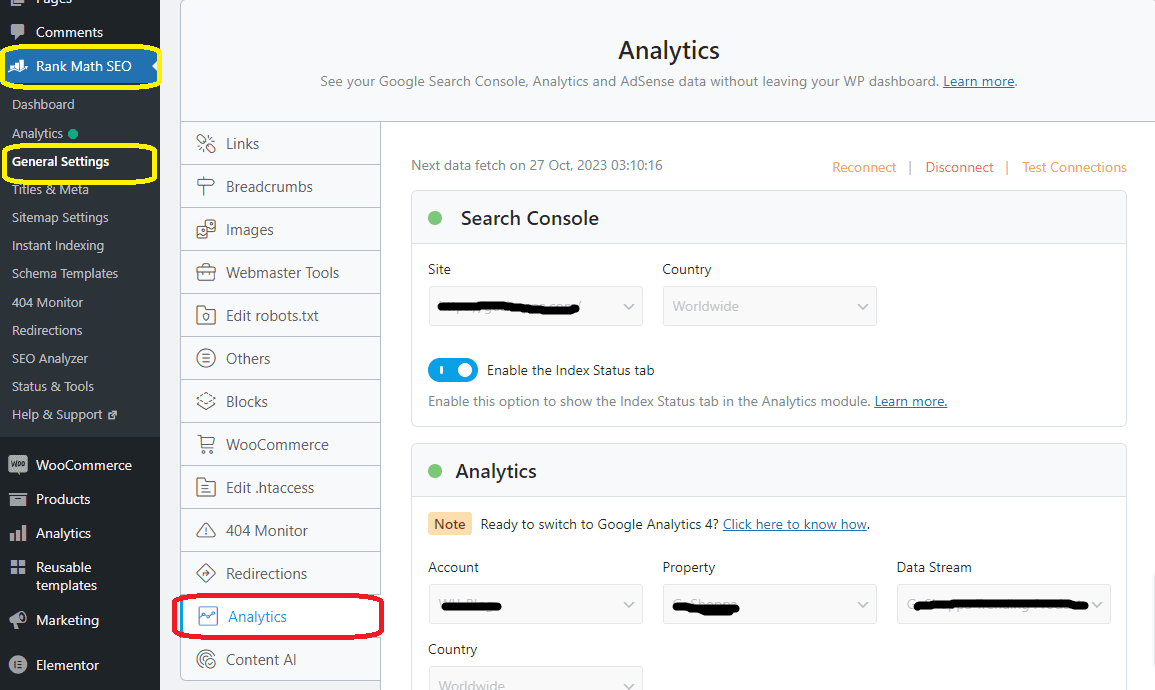
Recommended: 62 Best Free SEO Tools Every Digital Marketer Should Use
Step 4: Technical Optimization
While crafting compelling content is undoubtedly vital for SEO, the technical side of your product pages can't be underestimated. Technical SEO is the process of optimizing your website's technical structure and configuration to improve its crawl accessibility, indexability, and ranking in search engine results pages (SERPs).
For e-commerce websites, technical SEO is especially important because it can help to improve the user experience and conversion rates. For example, a fast-loading website is more likely to keep visitors engaged and encourage them to make a purchase.
Using Rank Math SEO for E-Commerce Technical SEO
Rank Math SEO comes with a number of features for technical SEO. To use Rank Math SEO for technical SEO, go to Rank Math SEO > Settings in your WordPress dashboard.
On the Settings page, you can configure a number of technical SEO settings, such as:
- Site speed optimization: Rank Math SEO can help you improve your website's loading speed by compressing your images, minifying your code, and enabling caching.
- Mobile optimization: Rank Math SEO can help you optimize your website for mobile devices by detecting mobile devices and redirecting them to the mobile version of your website.
- Canonicalization: Rank Math SEO can help you avoid duplicate content issues by automatically adding canonical tags to your web pages.
Specifically, here’s how to optimize your e-commerce product pages using Rank Math:
Step 4.1: Use Rank Math's Sitemaps Feature
Rank Math can automatically generate sitemaps for your e-commerce site, including product sitemaps and category sitemaps. This will help search engines crawl and index your pages more effectively.
Some of the things you can do with this feature include creating an HTML sitemap, automatically ping Google when your sitemap is updated exclude specific pages from your sitemap, and automatically translate Rank Math SEO XML sitemaps for multilingual website.
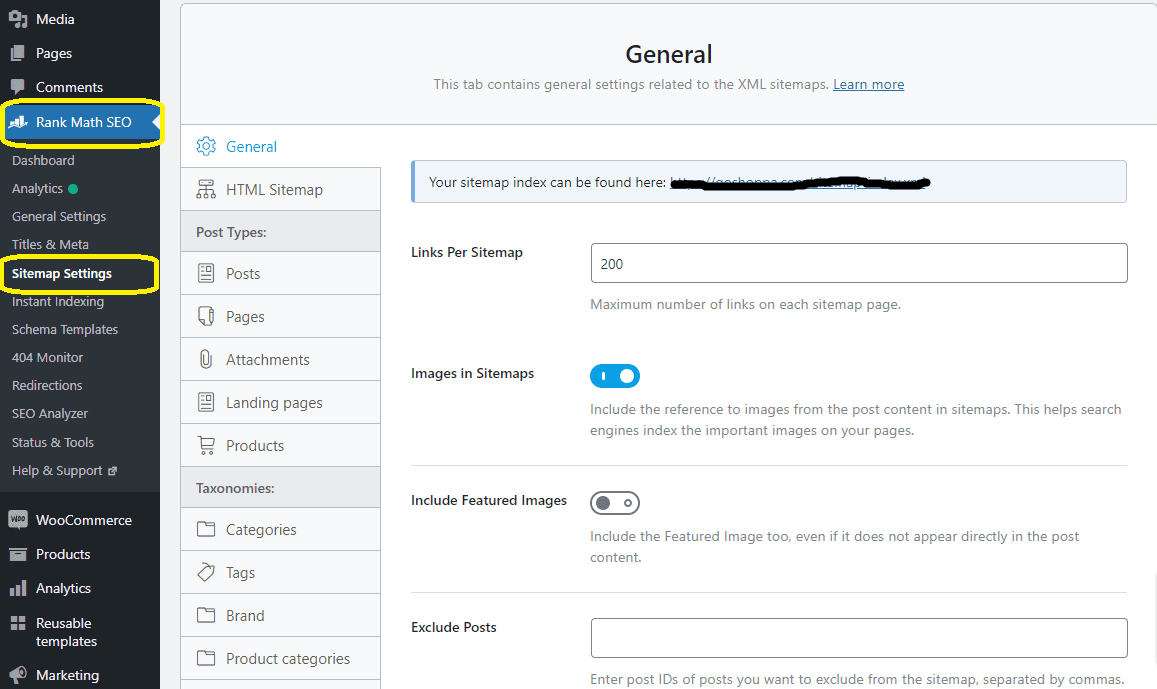
Step 4.2: Use Rank Math's Robots.txt Editor
Rank Math's Robots.txt Editor makes it easy to create and manage your robots.txt file for search engine optimization purposes. Within the editor, you have the freedom to make changes to the default robots.txt file to control how search engines crawl your site. This customization can include specifying which pages should be allowed or disallowed for indexing. You can also add sitemaps to your robots.txt file, further enhancing your website's SEO.
To access the editor, go to Rank Math SEO → General Settings → Edit robots.txt
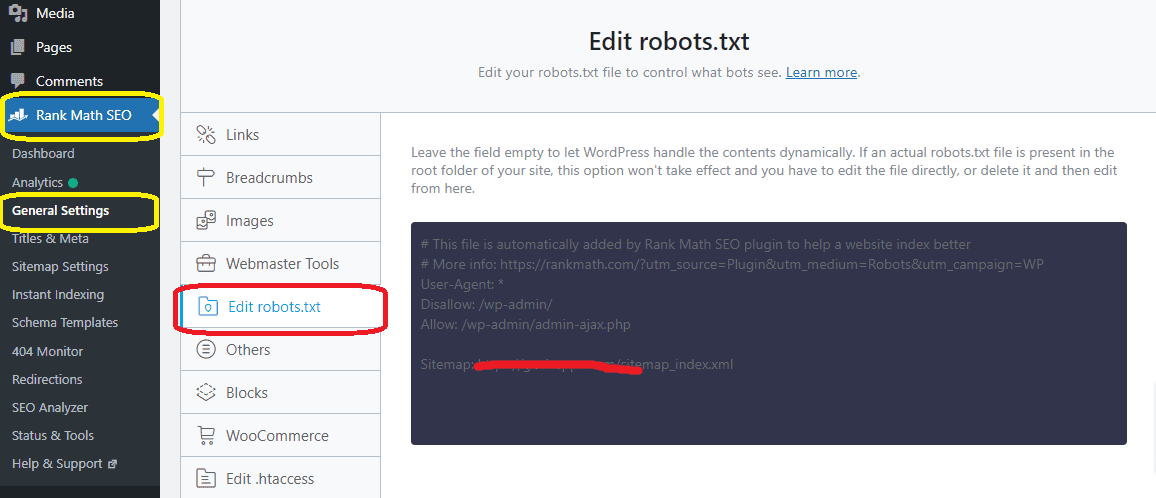
Step 4.3: Use Rank Math's Redirections Feature
Duplicate content issues are common with e-commerce sites. This can occur when multiple versions of a web page exist, such as a product page that is accessible from multiple URLs.
Because duplicate content can confuse Google and lead to lower search engine rankings, it’s important that you tell Google which version of your web page is the primary or “canonical” version by adding a canonical tag. You should also redirect users from the duplicate pages to the canonical page.
Rank Math's Redirections feature makes it easy to create and manage redirects on your e-commerce site.
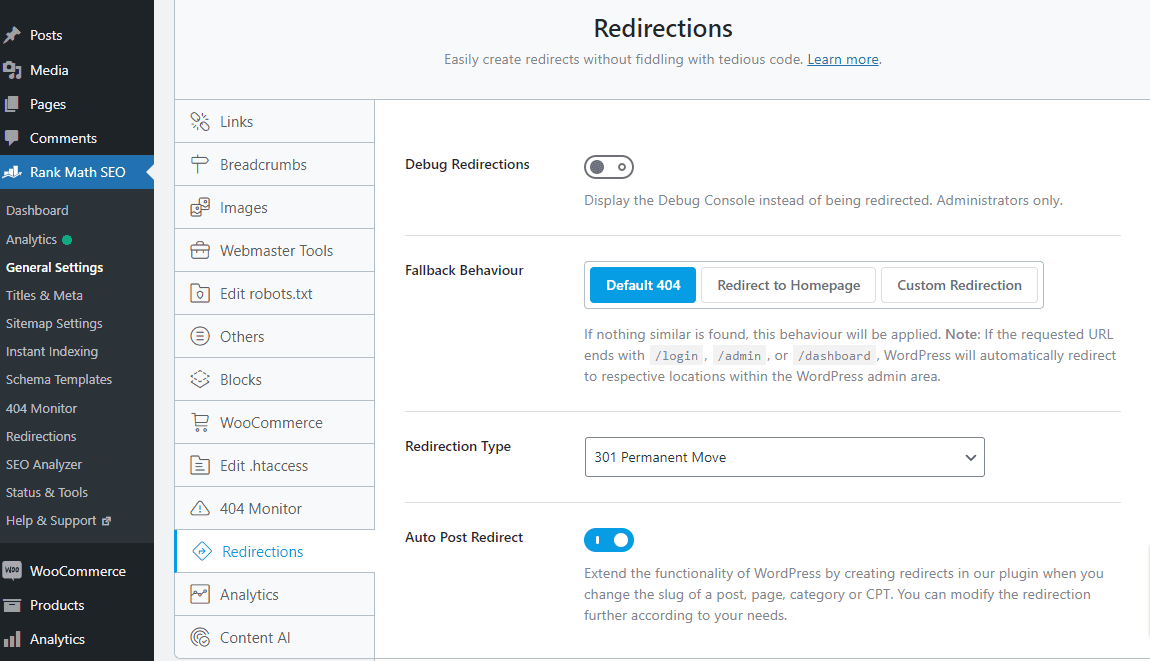
Step 4.4: Use Rank Math's Breadcrumbs Feature
Rank Math's Breadcrumbs feature adds breadcrumbs to your e-commerce site. Breadcrumbs are a type of navigation that shows users where they are on your site within the website hierarchy. This can help to improve the user experience and make it easier for users to find the pages they are looking for.
Breadcrumbs are also essential for SEO. You can access these settings in WordPress Dashboard → Rank Math SEO → General Settings → Breadcrumbs.
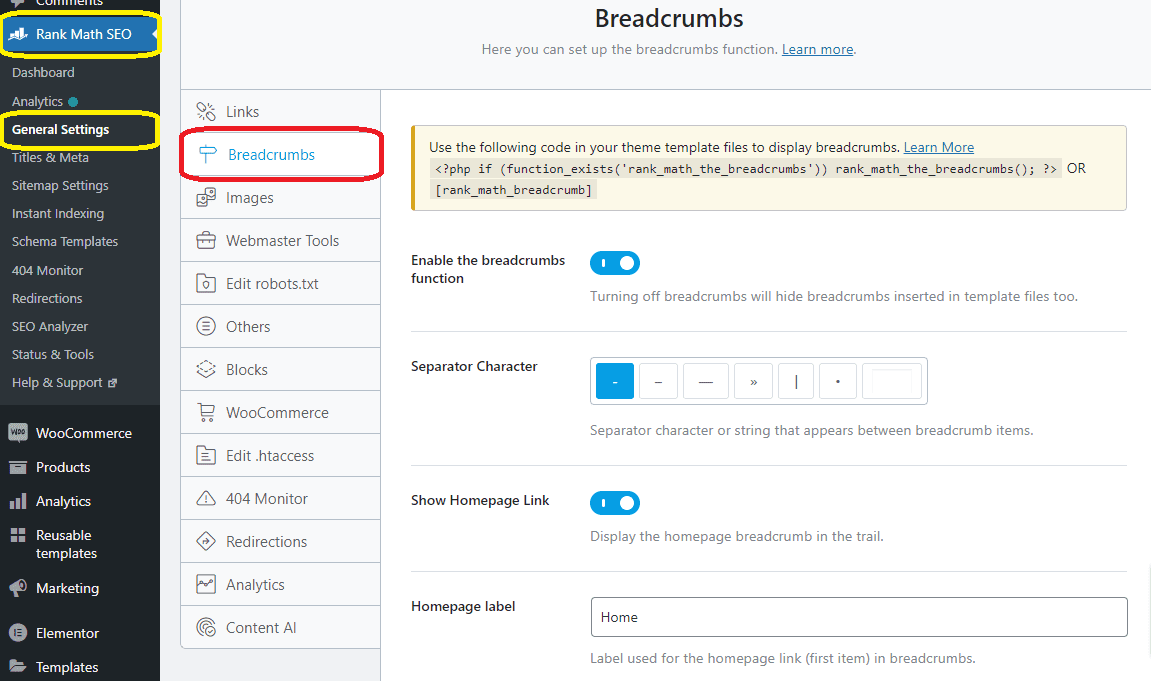
Step 4.5: Use Rank Math's Schema Markup Feature
Rank Math's Schema Markup feature makes it easy to add schema markup to your e-commerce site. Schema markup is a type of structured data that provides additional information about your products, such as price, availability, and reviews, to search engines. This can help search engines to better understand your content and display it in rich snippets in search results.
To set the schema type for product pages, navigate to Rank Math settings and configure the default schema type as “Product.” This ensures that product-specific schema markup is applied to your product pages. Once you've configured the default schema type, you can further enhance your product pages with schema markup.
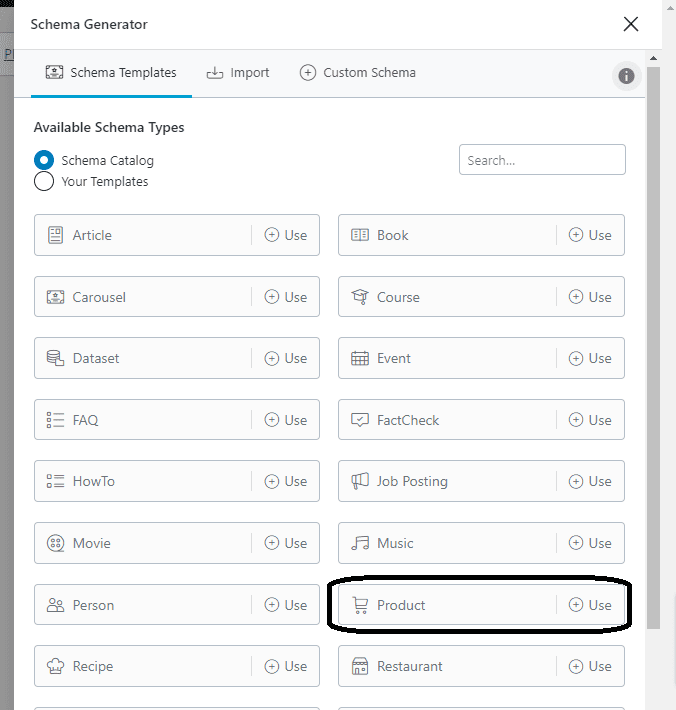
In addition to these features, Rank Math also includes a number of other features that can help you with e-commerce technical optimization, such as:
- 404 error monitoring and redirection
- XML-RPC pinging
- Heartbeats API
- Image optimization
- Minification and compression
By using Rank Math's e-commerce technical optimization features, you can improve your website's crawlability, indexability, and overall performance. This can lead to higher search engine rankings and more traffic to your site.
Step 5: Track and Monitor SEO efforts
Tracking and monitoring SEO efforts is a crucial part of optimizing a website's performance on search engines. Tracking SEO efforts is important for several reasons, including:
- Measuring SEO performance: Tracking SEO efforts helps measure the effectiveness of your SEO strategy and identify areas for improvement.
- Identifying opportunities: Tracking SEO efforts helps identify opportunities to increase organic search traffic and revenue.
- Monitoring threats: Tracking SEO efforts helps monitor threats to existing traffic and business.
- Evaluating success: Tracking SEO efforts helps evaluate the success of your SEO campaigns and demonstrate the value of your services to clients.
- Improving ROI: Focusing on metrics that deliver the greatest impact helps improve the ROI on marketing spend.
- Adapting to changes: SEO is always changing, and tracking SEO efforts helps ensure that your site is healthy, properly optimized, and producing business benefits.
- Establishing goals: Tracking SEO efforts helps establish specific, measurable, and achievable goals for your SEO campaigns.
- Providing insights: Tracking SEO efforts provides key insights into exactly how your organic search strategy performs, including rankings, traffic, engagement, leads, orders, revenue, and authority.
Tracking and Monitoring SEO Efforts with Rank Math
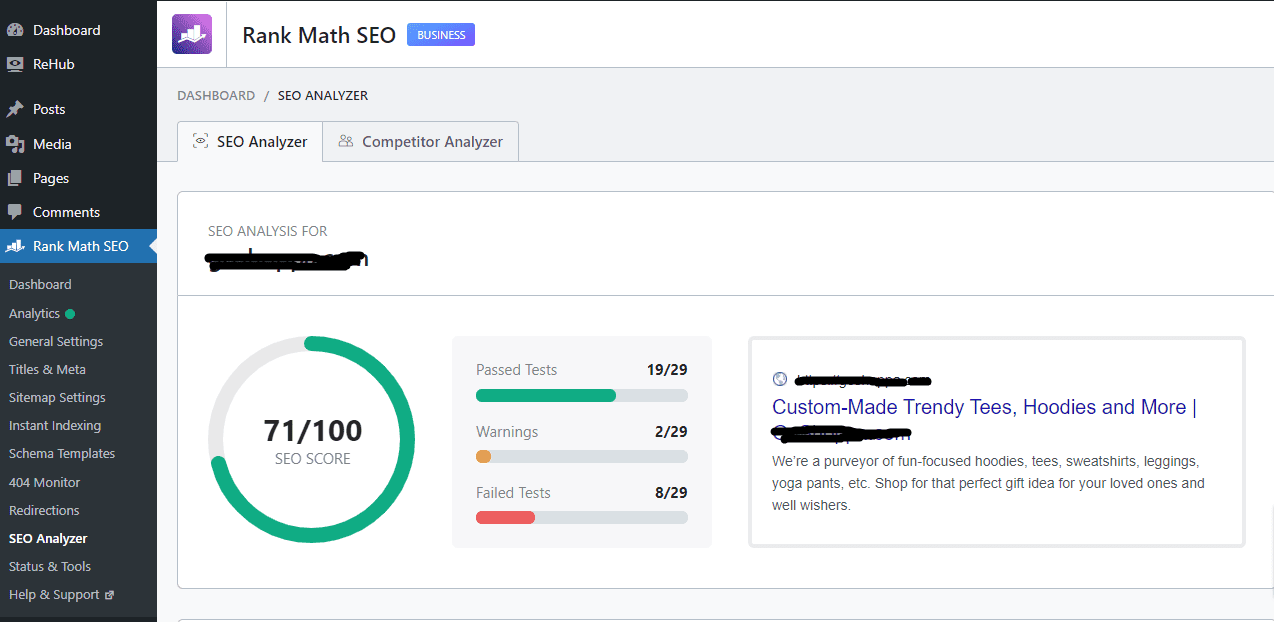
Rank Math SEO provides a number of tools for tracking and monitoring your SEO efforts. These tools can help you:
- Identify areas for improvement
- Track your progress over time
- Measure the impact of your SEO efforts
Here’s how to use Rank Math features for tracking and monitoring your SEO efforts:
Rank Tracker
The Rank Tracker allows you to track the rankings of your keywords in search engines. This can help you to see how your rankings are changing over time and to identify any keywords that are losing ground. You can access it by heading over to Rank Math SEO → Analytics → Rank Tracker inside your WordPress dashboard.
Google Search Console integration
Rank Math can be integrated with Google Search Console, which provides you with a wealth of data about your website's performance in search results. This data can be used to identify crawl errors, indexation issues, and other problems that could be impacting your SEO. With Rank Math's Google Search Console integration, you can also submit URLs for faster indexing and analyze rich results. All of these can help improve your website's SEO performance and attract more traffic.
To set up the Rank Math Google Search Console integration, you will need to:
- Install and activate the Rank Math SEO plugin.
- Create a Google Search Console account.
- Verify your website with Google Search Console.
- Connect your Rank Math SEO plugin with your Google Search Console account.
Once you have set up the integration, you will be able to view Google Search Console data within Rank Math. You can also use the integration to take action on Google Search Console data.
The Rank Math Google Search Console integration is a valuable tool for anyone who wants to improve their website's SEO. By using the integration, you can gain a deeper understanding of your website's SEO performance and make informed decisions about your SEO strategy.
Analytics integration
Rank Math can also be integrated with Google Analytics, which provides you with data about your website's traffic. This data can be used to see how your SEO efforts are impacting your website's traffic levels.
To set up the Rank Math Analytics integration, you will need to:
- Install and activate the Rank Math SEO plugin.
- Create a Google Analytics account.
- Add your website to your Google Analytics account.
- Connect your Rank Math SEO plugin with your Google Analytics account.
Once you have set up the integration, you will be able to view Google Analytics data within Rank Math. You can also use the integration to compare Google Analytics data with SEO data.
SEO Analysis Tool
The Rank Math SEO Analysis tool offers a comprehensive assessment of your website's SEO status, covering on-page and off-page SEO, technical aspects, content quality, and user experience. It evaluates elements like title tags, meta descriptions, backlinks, content quality, and more.
This tool provides scores and tailored recommendations for enhancing each of these aspects, allowing you to refine your website's SEO performance. By utilizing the Rank Math SEO Analysis tool, you can pinpoint areas that require enhancement, ensuring that your SEO efforts focus on high-impact elements.
The tool also enables you to monitor your progress and make informed decisions about your SEO strategy. This tool is invaluable for those looking to elevate their website's SEO, as it grants a deeper understanding of strengths and weaknesses, facilitating data-driven choices for SEO improvements.
SEO Reports
Rank Math can generate SEO reports that provide you with insights into your website's SEO performance. Rank Math SEO Reports offer several benefits that make it a valuable tool for website owners and SEO professionals. Here are some benefits of using Rank Math SEO Reports:
- Detailed SEO Performance Reports: Rank Math offers Detailed SEO Performance Reports via Email that lets you track changes related to website traffic, impressions, total keywords, and average position in your email reports. This feature is available for Rank Math PRO, Business, and Agency users.
- Monthly SEO Reports: Those using the free version of Rank Math can benefit from an SEO Report every month, giving you an overview of your site’s SEO performance.
- Customizable Reports: Business and Agency users can further Whitelabel the email reports delivered to their clients.Overview of SEO Performance: To give you an overview of your website’s SEO Performance, Rank Math pulls the data from your Google Search Console. Hence, to take advantage of our SEO Performance Reports, you’d need to connect your website with Google Account services and configure your Search Console settings under Rank Math SEO → General Settings → Analytics → Search Console.
- Comparison of Performance: The SEO Reports are designed in a way to help you quickly grasp your site’s performance by comparing your stats with the previous period. Rank Math displays your stats for the current period in black followed by a green or red number, comparing its performance to the previous data for the same time frame. While green indicates the gain in position/traffic/impressions.
Tips for Tracking and Monitoring Your SEO Efforts
Here are a few tips for tracking and monitoring your SEO efforts using Rank Math SEO:
- Set goals for your SEO efforts. This will help you to stay on track and to measure your progress.
- Track your rankings on a regular basis. This will help you to identify any changes in your rankings and to take corrective action if necessary.
- Monitor your website's traffic levels. This will help you to see how your SEO efforts are impacting your website's visibility.
- Analyze your website's SEO performance on a regular basis. This will help you to identify areas where your website can be improved for SEO.
- Use Rank Math's SEO reports to track your progress over time and to measure the impact of your SEO efforts.
Tracking and monitoring your SEO efforts is important for ensuring that your website is performing well in search engines. By using these Rank Math features you can track and monitor your SEO efforts. You will be able to identify what is working and any potential problems. This information can then be used to improve your SEO strategy and get better results.
Recommended: How to Use AI for SEO Optimization: A Comprehensive Guide
Product Page SEO Best Practices

Apart from the strategies above, here are some best practices when it comes to SEO for e-commerce websites:
- Fine-tune your keyword strategy: Keyword research is the foundation for product page optimization. Aligning product names with the search queries you're targeting goes a long way. Include the brand name, product name, model number, and useful information like dimensions.
- Optimize titles and meta descriptions: Use descriptive titles with brand names and keywords in text and alt text. Write engaging meta and product descriptions that accurately describe the product and include relevant keywords.
- Mark up product pages with structured data: Use structured data to help search engines understand your product pages better. All product pages should have product schema and review schema, which can drive more impressions and clicks, improve your click-through rate (CTR), and drive more sales.
- Add clear and helpful FAQs: High-quality content that meets the users’ needs is key to ranking high in search engine results pages (SERPs). Adding clear and helpful FAQs can help improve your website's SEO performance.
- Optimize your product descriptions: Write unique and compelling product descriptions that accurately describe the product and include relevant keywords. Use bullet points and subheadings to make the content easy to read and scan.
- Optimize your images and videos: Use high-quality images and videos that accurately represent the product. Optimize the file names, alt tags, and captions with relevant keywords.
- Use customer reviews and ratings: Customer reviews and ratings can help improve your website's SEO performance by providing fresh and unique content. Encourage customers to leave reviews and ratings and display them prominently on your product pages.
- Optimize your URL structure: Use descriptive and keyword-rich URLs that accurately describe the product. Avoid using generic or meaningless URLs.
- Optimize your breadcrumb menu: Use a breadcrumb menu to help users navigate your website and improve your website's SEO performance. Use descriptive and keyword-rich anchor text for each breadcrumb.
- Use product schema markup: Use product schema markup to help search engines understand your product pages better. This can help improve your website's SEO performance and attract more traffic.
By following these product page SEO best practices, you can improve your website's SEO performance and attract more traffic.
Recommended: 10 Must-Have Content Marketing Tools for Online Business Growth
FAQ on Product Page Optimization
How much content should be on a product page?
The ideal content length for a product page can vary, but it's generally recommended to have at least 300-500 words. However, the key is to provide comprehensive information that answers potential questions and addresses customer needs.
How do you check if a page is SEO-optimized?
You can use SEO tools like Rank Math to analyze your page for SEO optimization. Look for factors such as well-optimized meta tags, keyword usage, quality content, mobile-friendliness, and fast loading speed.
How do I know if my content is SEO-friendly?
SEO-friendly content is usually well-structured, includes relevant keywords, and provides value to the reader. To ensure it's SEO-friendly, perform keyword research, optimize headings and meta descriptions, and maintain high-quality, engaging content.
Does page performance affect SEO?
Yes, page performance significantly affects SEO. Google considers factors like page loading speed, mobile responsiveness, and user experience when ranking pages. Optimize your page's performance for better SEO results.
What should I avoid with SEO content?
Avoid keyword stuffing, duplicate content, and irrelevant links. Google penalizes such practices. Focus on creating valuable, unique, and informative content.
Do product titles affect SEO?
Absolutely. Product titles are crucial for SEO. They should be descriptive, include relevant keywords, and provide a clear idea of what the product is. A well-optimized title can improve your page's ranking.
What's the best way to optimize a product page for SEO?
To optimize a product page, focus on keyword research, create compelling product descriptions, use high-quality images, optimize meta tags, and ensure mobile-friendliness. User reviews and schema markup can also enhance SEO.
What is one good SEO practice when listing a product?
One essential practice is to create a unique and engaging product description that highlights the product's features and benefits. Use high-quality images, include relevant keywords, and offer structured information that guides customers to make informed decisions.
Conclusion
There you have it: our comprehensive guide to product page SEO. In this guide, you’ve learned the proven strategies for leveraging Rank Math to harness the power of SEO effectively for your ecommerce store.
There’s no doubt that the world of e-commerce is incredibly competitive. However, with these strategies coupled with the power of Rank Math, you can be sure of boosting your rankings and attracting more potential customers.
But remember ecommerce product page SEO is not a one-time task; it's an ongoing process. You will need to keep monitoring your performance and tracking your progress. Keep an eye on the ever-evolving SEO landscape and adapt your strategies accordingly.
Was this guide helpful in any way? Feel free to share it with your online contacts. Thanks for sharing the love!

